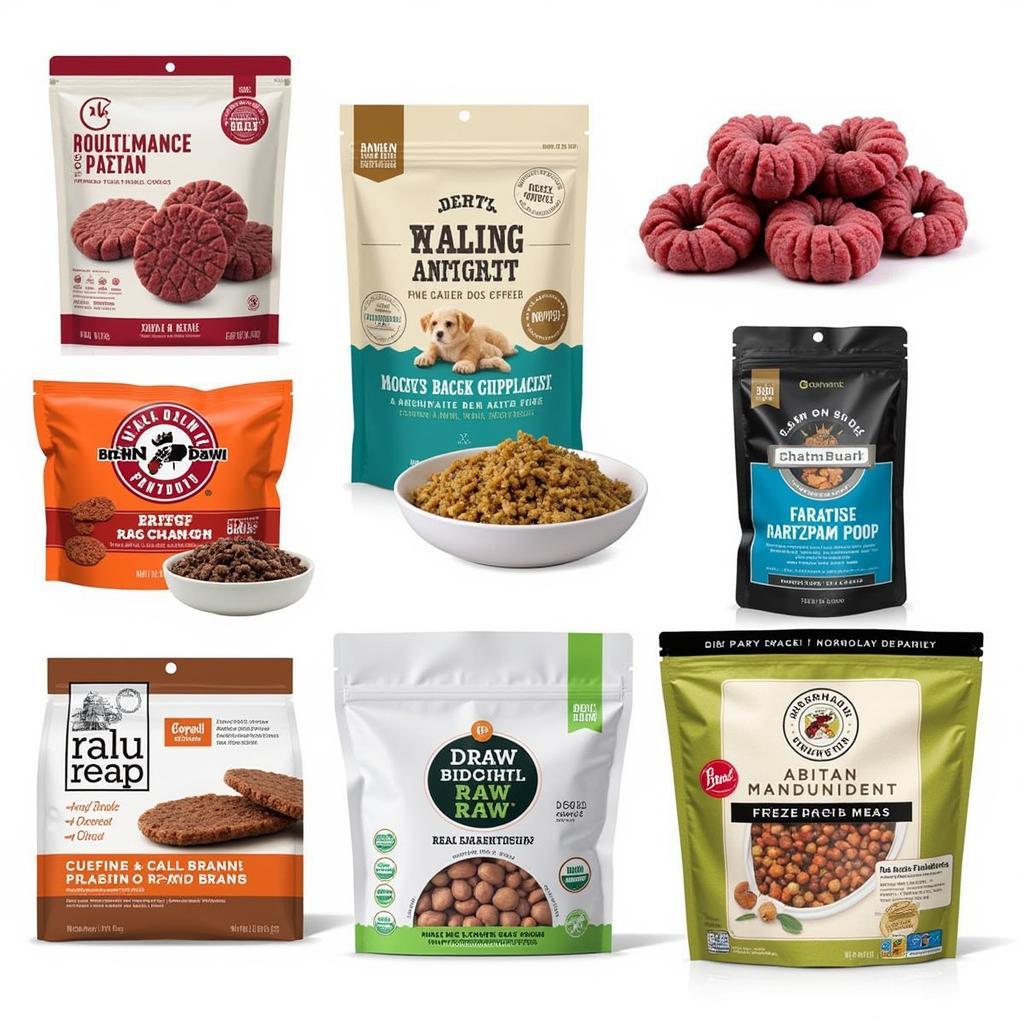Raw dog food has gained immense popularity amongst dog owners looking for a more natural and potentially healthier alternative to conventional kibble. But what exactly is a “complete” raw dog food diet, and how can you ensure your furry friend reaps its purported benefits? This comprehensive guide delves into the nuances of complete raw dog food, equipping you with the knowledge to make informed decisions for your canine companion.
Understanding Complete Raw Dog Food
The term “complete” in raw dog food signifies that the diet provides all the essential nutrients your dog needs for optimal health and well-being. Unlike homemade raw diets, which can be nutritionally imbalanced if not formulated meticulously, commercially prepared complete raw dog food products are carefully balanced to meet the specific nutritional requirements of dogs.
 Complete Raw Dog Food Options
Complete Raw Dog Food Options
These pre-made meals typically consist of muscle meat, organ meat, bone content (ground or whole), fruits, vegetables, and often additional supplements like vitamins, minerals, and probiotics. They aim to mimic a dog’s ancestral diet more closely, providing a range of nutrients in their most bioavailable form.
Benefits of Feeding Your Dog a Complete Raw Diet
Advocates of raw feeding cite numerous benefits, including:
- Improved Digestion: Proponents argue that the absence of grains and fillers in raw food can lead to better digestion and nutrient absorption.
- Shinier Coat and Healthier Skin: The higher moisture content and natural fats in raw diets are often linked to healthier skin and a shinier coat.
- Increased Energy Levels: Some owners observe increased energy and vitality in their dogs after switching to a raw diet.
- Dental Health: The act of chewing on raw meaty bones can help scrape away plaque and tartar buildup, potentially contributing to healthier teeth and gums.
 Thriving on Raw Food
Thriving on Raw Food
Choosing the Right Complete Raw Dog Food
Selecting the right complete raw food for your dog can seem daunting, given the plethora of options available. Here are some factors to consider:
- Life Stage: Puppies, adults, seniors, and pregnant or lactating dogs have different nutritional needs. Ensure you choose a product formulated for your dog’s specific life stage. For example, you might consider sweet potato and salmon dog food for its potential benefits for skin and coat health.
- Breed Size: Some brands offer formulas tailored to the needs of small, medium, and large breed dogs.
- Activity Level: Highly active dogs require a higher calorie intake than their more sedentary counterparts.
- Allergies and Sensitivities: Carefully scrutinize ingredient lists to avoid any potential allergens or ingredients your dog is sensitive to.
- Budget: Cheap raw dog food options are available, but remember to prioritize quality and complete nutrition over price alone.
Transitioning to a Complete Raw Food Diet
When transitioning your dog to a complete raw food diet, gradual introduction is key. Start by mixing a small amount of raw food with your dog’s current food, gradually increasing the ratio of raw food over a week or two. Monitor your dog closely for any digestive upset during this period.
 Gradual Transition to Raw
Gradual Transition to Raw
Addressing Common Concerns about Raw Feeding
- Bacterial Contamination: Sourcing your complete raw dog food from reputable manufacturers who adhere to strict safety standards is crucial to minimize the risk of bacterial contamination.
- Nutritional Deficiencies: While less likely with complete raw food products, it’s still essential to choose brands known for their balanced formulas. If you opt for a brand like Titan, be sure to research where to buy titan raw dog food from trusted suppliers.
- Cost: Complete raw dog food can be more expensive than kibble. However, exploring options like bulk raw dog food might help reduce costs.
- Mess and Preparation: Feeding a raw diet can be messier than kibble. However, many complete raw food options come in convenient pre-portioned packages that minimize mess.
Is Complete Raw Dog Food Right for Your Dog?
While complete raw dog food offers potential benefits, it’s not a one-size-fits-all solution. Consulting with your veterinarian is crucial to determine if a raw diet aligns with your dog’s individual needs and health status. They can assess your dog’s specific requirements, address any concerns you might have, and help you create a safe and successful transition plan.
Conclusion
Choosing the right diet for your dog is a significant decision. Complete raw dog food presents a compelling option for owners seeking a more natural and potentially beneficial feeding approach. By understanding the principles of complete raw feeding, selecting high-quality products, and working closely with your veterinarian, you can make an informed choice that supports your canine companion’s long-term health and happiness.
Remember, while this guide provides a comprehensive overview, it should not replace professional veterinary advice. Always consult with your veterinarian before making any significant changes to your dog’s diet.
FAQ
1. Can puppies eat a complete raw diet?
Yes, complete raw food formulated specifically for puppies can be a suitable option. These formulas cater to their unique growth and developmental needs.
2. Is raw feeding safe for dogs with food sensitivities?
Raw feeding can be beneficial for some dogs with sensitivities, as it eliminates common allergens like grains and certain protein sources. However, consult your vet to identify and avoid specific ingredients your dog might react to.
3. How do I store complete raw dog food?
Always follow the storage instructions on the product packaging. Typically, complete raw dog food needs to be kept frozen and thawed appropriately before serving.
4. Can I feed my dog raw bones?
Yes, raw meaty bones can be a part of a balanced raw diet, offering dental and mental stimulation benefits. However, choose bones appropriate for your dog’s size and chewing strength. Avoid cooked bones, as they can splinter and pose a choking hazard.
5. What are some signs my dog is not tolerating a raw diet?
Watch for signs like vomiting, diarrhea, gas, loss of appetite, or changes in stool consistency. If you observe any of these, consult your veterinarian promptly.
Need more information on specific dog breeds and raw feeding? Check out our article on the best dog food for amstaff.
Have further questions or need personalized advice? Contact us!
Phone Number: 02437655121
Email: minacones@gmail.com
Address: 3PGH+8R9, ĐT70A, thôn Trung, Bắc Từ Liêm, Hà Nội, Việt Nam.
Our dedicated customer support team is available 24/7 to assist you.